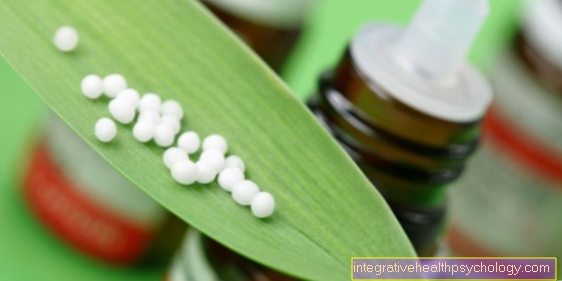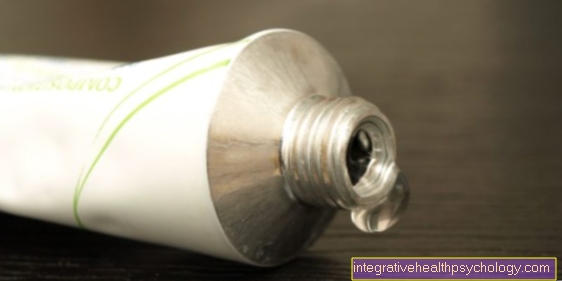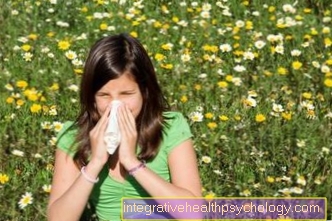Gargling for a sore throat
introduction
When the body has to fight off pathogens in the context of a cold, there are a few tricks that can be used to alleviate the symptoms. Especially in the first few days it is helpful to drink two to three liters and gargle regularly.
Gargling is perceived as beneficial by many people. If you use the right liquid to gargle, it can even help kill bacteria and speed healing. There are several different means of gargling, ranging from home remedies to mouthwashes.

Overview of the means for gargling
-
Thyme solution
-
Sage tea
-
Camomile tea
-
Arnica tea
-
Salt water
-
Lemon juice
-
Apple cider vinegar (with honey)
-
Coconut oil
-
Tea tree oil
-
Mint oil
-
Chlorhexamed®
-
Listerine
Home remedies for gargling
Various home remedies can be used to gargle. Ordinary chamomile tea or sage tea is suitable. To gargle, the tea is left to steep longer than usual so that the solution is more concentrated.
Lukewarm water with a few drops of mint oil or tea tree oil is also commonly used.
A tried and true home remedy for gargling for a sore throat is apple cider vinegar. To do this, add two teaspoons of apple cider vinegar and one tablespoon of honey to a glass of warm water. The mixture is said to have an anti-inflammatory and antibacterial effect.
All of these home remedies should be warmed up lukewarm to gargle and not swallowed.
Read more on the topic: Home remedies for a sore throat
Gargle with salt water
Gargling with salt water is a tried and tested home remedy for a sore throat. Table salt can be found in most households and is very cheap. To make a suitable salted water for gargling, put a teaspoon full of table salt in a container with ¼ liter of warm water.
The salt water moisturizes the mucous membranes in the mouth and throat area and also has a disinfectant effect. It is very suitable for relieving cold symptoms such as a sore throat. Gargle a sip of salt water every two to three hours. It is best to gargle for about two minutes and then spit out the salt water after gargling.
In the case of injuries such as wounds in the oral cavity, salt water should be avoided as the salt water burns in open wounds. In the case of injuries in the mouth and throat area, gargling with sage tea can be tried as a beneficial alternative.
Read more on the topic: Gargle with salt water - this is how it's done
Gargle with Listerine®
The Listerine® mouthwashes recommend daily use to keep the mouth healthy.
The mouthwashes have an antibacterial effect and are supposed to kill up to 97% of bacteria. They can be used for daily oral hygiene and gargled for half a minute to a minute and then spat out. The mouthwashes from Listerine® are also suitable for gargling for sore throats, coughs and runny nose. Since they have an antibacterial effect, they can prevent illnesses and relieve the progression and symptoms of a cold.
Read more on the topic: Mouthwash
Gargle with apple cider vinegar
Apple cider vinegar is a tried and true home remedy for gargling that has been used for numerous generations. You put two teaspoons of apple cider vinegar and one tablespoon of honey in a glass of warm water and gargle with it every 2 hours.
Apple cider vinegar is particularly popular because of its antibacterial and anti-inflammatory properties. It is also an inexpensive remedy that can be found in most households.
Gargle with coconut oil
Coconut oil has an antibacterial effect in the mouth.
“Oil pulling” with coconut oil is an Ayurvedic cleaning method for the mouth and can be tried as an alternative to gargling. To do this, you put a tablespoon of coconut oil in your mouth and rinse the oil back and forth. The oil is pulled, sucked and rinsed again and again between the teeth and the oil is allowed to work on different parts of the oral cavity. Oil pulling is done for up to 20 minutes.
Gargle with tea tree oil
Tea tree oil contains essential oils and valuable active ingredients such as terpinene and cineole. As a result, it has a strong anti-inflammatory effect and promotes wound healing in the skin and mucous membranes.
Tea tree oil is ideal for gargling with colds, irritations or wounds in the nasopharynx and gums. To do this, three to 5 drops of tea tree oil are put into a glass with lukewarm water. Gargle the tea tree oil solution for a minute or two and then spit it out.
Read more on the topic: Tea tree oil
Can gargling tea tree oil be dangerous too?
Tea tree oil is basically very gentle on tissue and wound healing. In rare cases, allergic reactions can still occur.
A small amount of pure tea tree oil should be put on the skin before gargling. If the test runs smoothly, nothing stands in the way of gargling. Tea tree oil should always be dissolved in water and never used pure for gargling.
Gargle with sage tea
Sage tea is beneficial for the throat and has a positive effect on the oral mucosa.
The sage tans the inflamed oral mucosa and soothes irritation of the mucous membranes. It is advisable to gargle with lukewarm sage tea several times a day, preferably every two hours. To get a strong solution, the sage tea should steep longer than usual.
Read more about this: Sage and its effects
Gargle with Chlorhexamed®
Chlorhexamed® is an antiseptic against numerous bacteria and fungi.
It can be used to prevent infection or to treat an existing infection. It can be bought over the counter in pharmacies and drug stores. Areas of application are all inflammations in the mouth and throat as well as tonsillitis, tooth inflammation, fungal infections and injuries in the oropharynx. You fill the Chlorhexamed® in the cap up to the mark and gargle for about a minute after meals.
Read more on the topic: Chlorhexamed®
Gargle with hydrogen peroxide
Hydrogen peroxide is available in every pharmacy and is used, for example, to disinfect wounds.
Hydrogen peroxide (H2O2) is a germicidal agent that can be used for various purposes. To gargle, hydrogen peroxide is mixed in equal parts with lukewarm water. Gargle the liquid every 2 hours for about 2 minutes. The mixture is not swallowed, but spat out after gargling. The hydrogen peroxide mixture kills bacteria. It is used to prevent flu and colds and alleviate symptoms in the event of illness. It is a kind of natural disinfectant.
Before use, you should speak to your doctor or pharmacist to ensure correct use.
How often should you gargle?
In order to alleviate the symptoms with gargling and accelerate healing, you should gargle the respective liquid or tea several times a day.
You can choose a recipe that suits you the most. Gargle about every two hours.
How long should you gargle?
For a solution gargle to be as effective as possible, it is best to gargle every two hours. You always take a sip of the liquid in your mouth and gargle for one to two minutes.
You can let the water run down your throat a little longer so that the throat is thoroughly flushed. The gargle should not be swallowed. Gargle each sip for a minute or two.





























